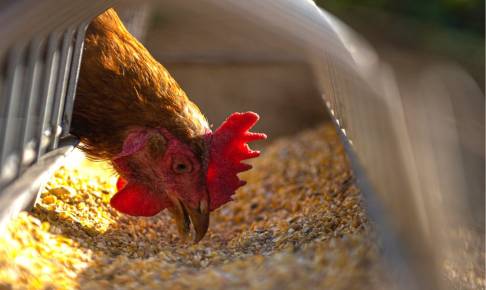Russia is set to heighten grain controls because of mycotoxins
A changing environment and ambitious plans to ramp up wheat exports pushes Russian veterinary watchdog Rosselhoznadzor to enhance control over the presence of mycotoxins in grain.
Rosselkhoznadzor is currently designing a new traceability system to ensure exported grain is free of mycotoxins. Russia needs to tighten control over the quality of exported grain to preserve its status as one of the main suppliers of grain on the global market, Russian Agricultural Minister Dmitry Patrushev said, justifying the need for the new system.In 2019, Russia exported 39.4 million tonnes of grain worth USD 7.9 billion to 133 counties. Patrushev expects this figure to grow to 45 million tonnes in 2020. As in previous years, wheat is expected to remain the primary export commodity. In 2020, Russia is set to export 36 million tonnes of wheat, Patrushev said. The Russian government earlier forecasted that the country could boost grain exports to 65 million tonnes per year by 2025. The new system will be similar to the Russian electronic veterinary certification system launched a few years ago: “Mercury”. Mercury proved its efficacy by almost completely eliminating counterfeit production from the Russian meat and dairy market. Rosselkhoznadzor was very satisfied with this system, said Sergey Dankvert, director of Rosselkhoznadzor.The new system may be necessary because recent findings by Russian scientists show that mycotoxin content in Russian grain has changed as harmful funguses are now being found in regions where they had not been present before.
Scientific basisThe widespread presence of mycotoxins in Russian grain over the past few years is one of the main reasons Rosselkhoznadzor must monitor grain quality more closely. Research conducted by the All-Russian Research Institute of Plant Protection showed that since 2017 there has been abnormal growth in the share of grain contaminated with Fusarium.The problem was especially concerning, in the so-called Black Earth region and North Caucasus, the researchers said. In total, 19 different types of molds producing mycotoxins were found, including some that have never been found in the country before. In some regions, the situation was critical. For example, in Krasnodar Krai up to 96% of all winter wheat and barley had been damaged by Fusarium and quite a few samples were contaminated by mycotoxins associated with Fusarium.The researchers said that one potential theory to explain this phenomenon is that Fusarium was able to take advantage of global climate change. Another theory is that in the past few years Fusarium somehow grew accustomed to the harsh weather conditions in Russia. There are no clear answers but the fact is that Fusariumis appearing more widely in Russian wheat. Other recent research conducted by the Tyumen State University also confirmed the presence of mycotoxins in Volga, Siberia, and the Urals.The most important observation was the detection of F. graminearum in the Ural and West Siberian regions, where this pathogen had never before been found. The grains most damaged by F. graminearum and F. sporotrichioides were found in West Siberia. The DNA of F. graminearum was detected in 19.2% of the samples and the DNA of F. sporotrichioides was found in 84.1% of the samples.The number of Fusarium antigens in the grain samples from the West Siberian region was found to be seven to eight times higher than the number of antigens found in the samples from the other two regions.
Rosselkhoznadzor is currently designing a new traceability system to ensure exported grain is free of mycotoxins. Russia needs to tighten control over the quality of exported grain to preserve its status as one of the main suppliers of grain on the global market, Russian Agricultural Minister Dmitry Patrushev said, justifying the need for the new system.In 2019, Russia exported 39.4 million tonnes of grain worth USD 7.9 billion to 133 counties. Patrushev expects this figure to grow to 45 million tonnes in 2020. As in previous years, wheat is expected to remain the primary export commodity. In 2020, Russia is set to export 36 million tonnes of wheat, Patrushev said. The Russian government earlier forecasted that the country could boost grain exports to 65 million tonnes per year by 2025. The new system will be similar to the Russian electronic veterinary certification system launched a few years ago: “Mercury”. Mercury proved its efficacy by almost completely eliminating counterfeit production from the Russian meat and dairy market. Rosselkhoznadzor was very satisfied with this system, said Sergey Dankvert, director of Rosselkhoznadzor.The new system may be necessary because recent findings by Russian scientists show that mycotoxin content in Russian grain has changed as harmful funguses are now being found in regions where they had not been present before.
Scientific basisThe widespread presence of mycotoxins in Russian grain over the past few years is one of the main reasons Rosselkhoznadzor must monitor grain quality more closely. Research conducted by the All-Russian Research Institute of Plant Protection showed that since 2017 there has been abnormal growth in the share of grain contaminated with Fusarium.The problem was especially concerning, in the so-called Black Earth region and North Caucasus, the researchers said. In total, 19 different types of molds producing mycotoxins were found, including some that have never been found in the country before. In some regions, the situation was critical. For example, in Krasnodar Krai up to 96% of all winter wheat and barley had been damaged by Fusarium and quite a few samples were contaminated by mycotoxins associated with Fusarium.The researchers said that one potential theory to explain this phenomenon is that Fusarium was able to take advantage of global climate change. Another theory is that in the past few years Fusarium somehow grew accustomed to the harsh weather conditions in Russia. There are no clear answers but the fact is that Fusariumis appearing more widely in Russian wheat. Other recent research conducted by the Tyumen State University also confirmed the presence of mycotoxins in Volga, Siberia, and the Urals.The most important observation was the detection of F. graminearum in the Ural and West Siberian regions, where this pathogen had never before been found. The grains most damaged by F. graminearum and F. sporotrichioides were found in West Siberia. The DNA of F. graminearum was detected in 19.2% of the samples and the DNA of F. sporotrichioides was found in 84.1% of the samples.The number of Fusarium antigens in the grain samples from the West Siberian region was found to be seven to eight times higher than the number of antigens found in the samples from the other two regions.
Download content now





















